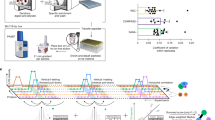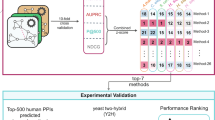Abstract
Systematic mapping of protein–protein interactions, or ‘interactome’ mapping, was initiated in model organisms, starting with defined biological processes1,2 and then expanding to the scale of the proteome3,4,5,6,7. Although far from complete, such maps have revealed global topological and dynamic features of interactome networks that relate to known biological properties8,9, suggesting that a human interactome map will provide insight into development and disease mechanisms at a systems level. Here we describe an initial version of a proteome-scale map of human binary protein–protein interactions. Using a stringent, high-throughput yeast two-hybrid system, we tested pairwise interactions among the products of ∼8,100 currently available Gateway-cloned open reading frames and detected ∼2,800 interactions. This data set, called CCSB-HI1, has a verification rate of ∼78% as revealed by an independent co-affinity purification assay, and correlates significantly with other biological attributes. The CCSB-HI1 data set increases by ∼70% the set of available binary interactions within the tested space and reveals more than 300 new connections to over 100 disease-associated proteins. This work represents an important step towards a systematic and comprehensive human interactome project.
This is a preview of subscription content, access via your institution
Access options
Subscribe to this journal
Receive 51 print issues and online access
$199.00 per year
only $3.90 per issue
Buy this article
- Purchase on Springer Link
- Instant access to full article PDF
Prices may be subject to local taxes which are calculated during checkout



Similar content being viewed by others
References
Fromont-Racine, M., Rain, J. C. & Legrain, P. Toward a functional analysis of the yeast genome through exhaustive two-hybrid screens. Nature Genet. 16, 277–282 (1997)
Walhout, A. J. et al. Protein interaction mapping in C. elegans using proteins involved in vulval development. Science 287, 116–122 (2000)
Uetz, P. et al. A comprehensive analysis of protein-protein interactions in Saccharomyces cerevisiae. Nature 403, 623–627 (2000)
Ito, T. et al. A comprehensive two-hybrid analysis to explore the yeast protein interactome. Proc. Natl Acad. Sci. USA 98, 4569–4574 (2001)
Reboul, J. et al. C. elegans ORFeome version 1.1: experimental verification of the genome annotation and resource for proteome-scale protein expression. Nature Genet. 34, 35–41 (2003)
Giot, L. et al. A protein interaction map of Drosophila melanogaster. Science 302, 1727–1736 (2003)
Li, S. et al. A map of the interactome network of the metazoan C. elegans. Science 303, 540–543 (2004)
Jeong, H., Mason, S. P., Barabasi, A. L. & Oltvai, Z. N. Lethality and centrality in protein networks. Nature 411, 41–42 (2001)
Han, J. D. et al. Evidence for dynamically organized modularity in the yeast protein–protein interaction network. Nature 430, 88–93 (2004)
Vidal, M. A biological atlas of functional maps. Cell 104, 333–339 (2001)
Xenarios, I. et al. DIP, the Database of Interacting Proteins: a research tool for studying cellular networks of protein interactions. Nucleic Acids Res. 30, 303–305 (2002)
Zanzoni, A. et al. MINT: a Molecular INTeraction database. FEBS Lett. 513, 135–140 (2002)
Bader, G. D., Betel, D. & Hogue, C. W. BIND: the Biomolecular Interaction Network Database. Nucleic Acids Res. 31, 248–250 (2003)
Peri, S. et al. Development of human protein reference database as an initial platform for approaching systems biology in humans. Genome Res. 13, 2363–2371 (2003)
Pagel, P. et al. The MIPS mammalian protein-protein interaction database. Bioinformatics 21, 832–834 (2005)
Lehner, B. & Fraser, A. A first-draft human protein-interaction map. Genome Biol. 5, R63 (2004)
Rual, J. F. et al. Human ORFeome version 1.1: a platform for reverse proteomics. Genome Res. 14, 2128–2135 (2004)
International Human Genome Sequencing Consortium. Finishing the euchromatic sequence of the human genome. Nature 431, 931–945 (2004)
Walhout, A. J. & Vidal, M. A genetic strategy to eliminate self-activator baits prior to high-throughput yeast two-hybrid screens. Genome Res. 9, 1128–1134 (1999)
Gavin, A. C. et al. Functional organization of the yeast proteome by systematic analysis of protein complexes. Nature 415, 141–147 (2002)
Formstecher, E. et al. Protein interaction mapping: A Drosophila case study. Genome Res. 15, 376–384 (2005)
Xie, X. et al. Systematic discovery of regulatory motifs in human promoters and 3′ UTRs by comparison of several mammals. Nature 434, 338–345 (2005)
Eppig, J. T. et al. The Mouse Genome Database (MGD): from genes to mice—a community resource for mouse biology. Nucleic Acids Res. 33, D471–D475 (2005)
Camon, E. et al. The Gene Ontology Annotation (GOA) Database: sharing knowledge in Uniprot with Gene Ontology. Nucleic Acids Res. 32, D262–D266 (2004)
Gunsalus, K. C. et al. Predictive models of molecular machines involved in Caenorhabditis elegans early embryogenesis. Nature 436, 861–865 (2005)
Wagner, A. The yeast protein interaction network evolves rapidly and contains few redundant duplicate genes. Mol. Biol. Evol. 18, 1283–1292 (2001)
Bader, G. D. & Hogue, C. W. An automated method for finding molecular complexes in large protein interaction networks. BMC Bioinformatics 4, 2 (2003)
Berriz, G. F., King, O. D., Bryant, B., Sander, C. & Roth, F. P. Characterizing gene sets with FuncAssociate. Bioinformatics 19, 2502–2504 (2003)
Huang, X. et al. Overexpression of human reticulon 3 (hRTN3) in astrocytoma. Clin. Neuropathol. 23, 1–7 (2004)
Johnson, J. M. et al. Genome-wide survey of human alternative pre-mRNA splicing with exon junction microarrays. Science 302, 2141–2144 (2003)
Acknowledgements
This paper is dedicated to the memory of Stan Korsmeyer. We thank members of the Vidal laboratory and the participants of the ORFeome Meeting for discussions; the sequencing staff at Agencourt Biosciences for technical assistance; E. Smith for his help with the figures; C. McCowan, A. Bird, T. Clingingsmith and C. You for administrative assistance; and E. Benz, S. Korsmeyer, D. Livingston, P. McCue, J. Song, B. Rollins and the DFCI Strategic Planning Initiative for support. Our human interactome project is supported by the DFCI High-Tech Fund (S. Korsmeyer), an Ellison Foundation grant awarded to M.V., an NIH/NCI grant awarded to S. Korsmeyer, S. Orkin, G. Gilliland and M.V., an ‘interactome mapping’ grant from NIH/NHGRI and NIH/NIGMS awarded to F.P.R. and M.V., and a W.M. Keck Foundation grant awarded to E. Benz, J. Marto, F.P.R. and M.V. Other support includes Taplin Funds for Discovery (F.P.R., F.D.G. and G.F.B), a 2003 NSF Fellowship (D.S.G) and funding from the Fonds National de la Recherche Scientifique, Belgium (M.D.). Author Contributions Experiments and data analyses were coordinated by J.F.R., T.H. and K.V. High-throughput ORF cloning and yeast two-hybrid screens were performed by J.F.R., T.H.K., A.D., N.L., N.A.G., J.R. and J.L. J.F.R developed the high-throughput yeast two-hybrid strategy. Computational analyses were performed by T.H., K.V., G.F.B., F.D.G., N.K., P.L., D.S.G., L.V.Z., S.L.W. and G.F. Co-affinity purification experiments were performed by M.D., C.S., J.F.R., S.M., M.B., S.L. and J.S.A. C.F., E.L., S.C. and C.B. provided laboratory support. R.S.S., J.V., H.Y.Z., A.S. and M.E.C. helped with the overall interpretation of the data. DNA sequencing was performed by S.B., R.S. and L.D.S. The manuscript was written by J.F.R., K.V., M.E.C., D.E.H., F.P.R. and M.V. The project was conceived by M.V. and co-directed by D.E.H., F.P.R. and M.V.
Author information
Authors and Affiliations
Corresponding authors
Ethics declarations
Competing interests
Reprints and permissions information is available at npg.nature.com/reprintsandpermissions. The authors declare no competing financial interests.
Supplementary information
Supplementary Data
This file contains expanded information regarding various concepts discussed in the main paper, plus a Methods section. In addition, this file has a Supplementary Methods section and legends for the Supplementary Figures and Tables. (DOC 518 kb)
Supplementary Figure S1a
Filtering and quality assessment of Y2H interactions. (PDF 451 kb)
Supplementary Figure S1b
Filtering and quality assessment of Y2H interactions. (PDF 33623 kb)
Supplementary Figure S1c
Filtering and quality assessment of Y2H interactions. (PDF 3236 kb)
Supplementary Figure S2
Bias in network neighborhoods for either CCSB-HI1 or LCI interactions. (PDF 225 kb)
Supplementary Figure S3
Occurrence of CCSB-HI1-associated, LCI-associated associated gene pairs in Pubmed or Google Scholar searches. (PDF 200 kb)
Supplementary Figure S4a
Correlation of interaction data with other gene- or protein-pair characteristics. (PDF 1646 kb)
Supplementary Figure S4b
Correlation of interaction data with other gene- or protein-pair characteristics. (PDF 233 kb)
Supplementary Figure S5a
Network analyses of CCSB-HI1. (PDF 181 kb)
Supplementary Figure S5b
Network analyses of CCSB-HI1. (PDF 182 kb)
Supplementary Figure S5c
Network analyses of CCSB-HI1. (PDF 247 kb)
Supplementary Figure S5d
Network analyses of CCSB-HI1. (PDF 108 kb)
Supplementary Figure S6a
Sub-networks of putative biological modules. (PDF 476 kb)
Supplementary Figure S6b
Sub-networks of putative biological modules. (PDF 262 kb)
Supplementary Figure S6c
Sub-networks of putative biological modules. (PDF 191 kb)
Supplementary Table S1
List of all human ORFs in Space-I that were tested for Y2H interactions. (XLS 226 kb)
Supplementary Table S2
List of CCSB-HI1 and LCI binary interactions along with annotation. (XLS 254 kb)
Supplementary Table S3
List of CCSB-HI1 and LCI interactions that were tested in co-AP experiments. (XLS 6 kb)
Supplementary Table S4
List of over-represented and under-represented Pfam-A domains in CCSB-HI1 and LCI data sets. (XLS 23 kb)
Supplementary Table S5
Analysis of overlap between CCSB-HI1 or LCI-interacting protein-pairs with other shared gene- or protein-pair characteristics. (XLS 43 kb)
Supplementary Table S6
Statistics of CCSB-HI1interactions between proteins in different evolutionary classes. (XLS 20 kb)
Supplementary Table S7
List of 172 MCODE-generated clusters from the CCSB-HI1 network and the combined CCSB-HI1/LCI and CCSB-HI1/LC networks. (XLS 197 kb)
Supplementary Table S8
Potentially novel associations of proteins with genetic disorders as revealed by the CCSB-HI1 interaction data set. (XLS 89 kb)
Rights and permissions
About this article
Cite this article
Rual, JF., Venkatesan, K., Hao, T. et al. Towards a proteome-scale map of the human protein–protein interaction network. Nature 437, 1173–1178 (2005). https://doi.org/10.1038/nature04209
Received:
Accepted:
Published:
Issue Date:
DOI: https://doi.org/10.1038/nature04209
This article is cited by
-
Hypergraph geometry reflects higher-order dynamics in protein interaction networks
Scientific Reports (2022)
-
Reviving a failed network through microscopic interventions
Nature Physics (2022)
-
Gene Ontology GAN (GOGAN): a novel architecture for protein function prediction
Soft Computing (2022)
-
Endophenotype-based in silico network medicine discovery combined with insurance record data mining identifies sildenafil as a candidate drug for Alzheimer’s disease
Nature Aging (2021)
-
Classification and prediction of protein–protein interaction interface using machine learning algorithm
Scientific Reports (2021)
Comments
By submitting a comment you agree to abide by our Terms and Community Guidelines. If you find something abusive or that does not comply with our terms or guidelines please flag it as inappropriate.



